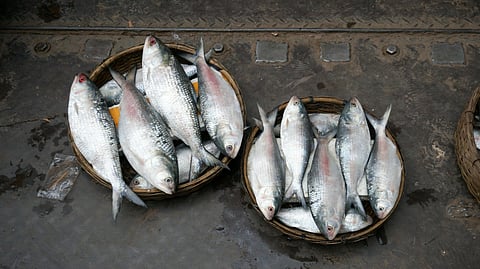
- LIFESTYLE
- FASHION
- FOOD
- ENTERTAINMENT
- EVENTS
- CULTURE
- VIDEOS
- WEB STORIES
- GALLERIES
- GADGETS
- CAR & BIKE
- SOCIETY
- TRAVEL
- NORTH EAST
- INDULGE CONNECT

If you are a foodie who waits all year round for the monsoons to relish the tastiest hilsa, then you are not new to the Padma or Ganga ilish debate. Now understand the basics, Ganga is part of the river that flows from thousands of miles originating from the Gangotri and finally meeting the Bay of Bengal. Padma, on the other hand is a major distributary of the Ganges and flows across Bangladesh. Bengal is situated geographically such, that the people can choose from Ilish originating in either of the rivers. But the main question is which one finally makes to the plates?
For those who regularly eat fish or are foodies who understand the minute parameters of what they are consuming, would be able to understand the finer differences between the two. But for the general onlooker, Padma ilish or Ganga hilsa can be generally differentiated by some visible and flavour parameters.
Texture test
If you are looking for a melt-in-the-mouth ilish, then go for the ones found in the Padma river whereas Ganga Hilsa is a little more firm. The former is often softer, tender and have higher fat content than the latter. One of the quality pick tests include pressing down on the fish body and see if it leaves a dent and then retracts back. If it does not retract that means it’s a bad fish; and if it does, it signifies it’s a fish that can well go to your kitchens that day.
Finer flavours
The ilish which comes from the Padma river has a more buttery and smooth taste. It is rich and strong and is often considered to be a full-body fish. This is because of the high fat content which also gives it a higher oily feel; whereas, Ganga Ilish is less oily and has a more subtle taste as compared to the overbearing taste of the other.
Size it up!
For ilish, even the statement, the bigger the better becomes an understatement because people love to devour the fish. Padma offers large hilsa, good enough to be devoured by two to three people who love to eat the fish while Ganga ilish are comparatively smaller in size.
Pocket pinch
Padma ilish is on the expensive side. Rounding off its size, flavour and the fact that it is available due to trade between India and Bangladesh, the price is definitely high. Ganga ilish, on the other hand is a local catch and thus does not drill a hole in the pockets.
After analyzing the pros and cons of both types of fish, it is completely up to you to decide which one earns a spot for the special monsoon treat o your plate!
For more updates, join/follow our WhatsApp, Telegram and YouTube channels.